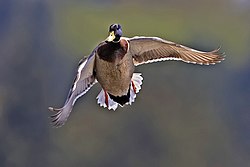Avialae
| Avialans Temporal range: Late Jurassic–Recent,
| |
|---|---|

| |
| Mallard in midflight. | |
| Scientific classification | |
| Kingdom: | |
| Phylum: | |
| Class: | |
| Superorder: | |
| Order: | |
| Suborder: | |
| (unranked): | Avialae Gauthier, 1986
|
| Sub-clades | |
|
Clades vary by definition, see text. | |
Avialae ("bird wings") is a clade containing birds (Aves) and their most immediate dinosaurian relatives.
Competing definitions
Systematic studies of the Avialae have produced different results depending on the specimens included and the definitions used. Including or excluding Archaeopteryx from the group Aves has a large effect on the subgroups of Avialae. Specifically, if Archaeopteryx is defined as an avian, then there are few non-avian avialans.
Archaeopteryx from the late Jurassic Period may be the earliest known theropod dinosaur which may have had the capability of powered flight.[1] Archaeopteryx is included within Avialae, and it is the avialan with the oldest reliable estimate of geological age at this time.
Character-based definition
Avialae is traditionally defined as an apomorphy-based clade (that is, one based on physical characteristics). Jacques Gauthier named Avialae in 1986, and first defined it in 2001 as all dinosaurs that possessed feathered wings used in flapping flight, and the birds that descended from them.[2][3]
Avialae vs. Aves
Gauthier [3] (page 34) identified four conflicting ways of defining the term "Aves", which is a problem because the same biological name is being used four different ways. Gauthier proposed a solution, number 4 below, which is to reserve the term Aves only for the last common ancestor of all living birds and all of its descendants. He assigned other names to the other groups.
- Aves can mean those advanced archosaurs with feathers (alternately Avifilopluma)
- Aves can mean those that fly (alternately Avialae)
- Aves can mean all reptiles closer to birds than to crocodiles (alternately Panaves)
- Aves can mean the last common ancestor of all the currently living birds and all of its descendants (a "crown group"). (alternately Neornithes)
Under the fourth definition Archaeopteryx is an avialan, and not a member of Aves. Gauthier's restriction of Aves to modern birds has not been widely adopted in the paleontological literature.
Branch-based definition
Several authors have use a similar, but branch-based, definition; "all theropods closer to birds than to Deinonychus."[4][5]
In 2002, Clarke and Norell[6] used this definition in publishing a rigorously detailed phylogeny of known avialans. In their results on page 26, they organized the Avialae in successive stages of evolution, which are arranged here from most primitive at top to most advanced at bottom;
- Dromaeosauridae is an outgroup, but a member of Avifilopluma
- Archaeopteryx is the most basal Avialan
- Confuciusornithidae are the most basal pygostylian
- Enantiornithes are the most basal members of Ornithothoraces
- Vorona
- Patagopteryx
- Apsaravis is the most basal member of Ornithurae
- Baptornis + Hesperornis
- Ichthyornis
- Aves (crown group definition)
- Ichthyornis
- Baptornis + Hesperornis
- Apsaravis is the most basal member of Ornithurae
- Patagopteryx
- Vorona
- Enantiornithes are the most basal members of Ornithothoraces
- Confuciusornithidae are the most basal pygostylian
- Archaeopteryx is the most basal Avialan
Non-Avian Avialans
There are three taxa that are not members of Aves, but are avialans, in any definition of Avialae listed above.
Senter (2007) placed Epidendrosaurus as a sister group to Archaeopteryx within Avialae.[7] The age of the Daohugou Beds where Epidendrosaurus was collected may be Middle Jurassic; older than Archaeopteryx.
A study by Zhang et al. (2008) confirmed that Epidendrosaurus was within Avialae and also added a new taxon, Epidexipteryx.[8]
Xu et al. (2009) described Anchiornis, another non-avian avialan from western Liaoning, China. They found that it is the most basal, or primitive, avialan yet described. Anchiornis is of uncertain Cretaceous-Jurassic age.[9]
References
- ^ Alonso, P. D., Milner, A. C., Ketcham, R. A., Cookson, M. J. & Rowe, T. B. (2004). The avian nature of the brain and inner ear of Archaeopteryx. Nature. 430(7000): 666–669. PMID 15295597. doi:10.1038/nature02706. PDF fulltext Supplementary info
- ^ Gauthier, J. (1986). "Saurischian monophyly and the origin of birds." In: K. Padian, ed. The origin of birds and the evolution of flight. San Francisco: California, Acad.Sci. pp.1–55. (Mem.Calif.Acad.Sci.8.)
- ^ a b Gauthier, J., and de Queiroz, K. (2001). "Feathered dinosaurs, flying dinosaurs, crown dinosaurs, and the name Aves." Pp. 7-41 in New perspectives on the origin and early evolution of birds: proceedings of the International Symposium in Honor of John H. Ostrom (J. A. Gauthier and L. F. Gall, eds.). Peabody Museum of Natural History, Yale University, New Haven, Connecticut, U.S.A.
- ^ Weishampel, David B.; Dodson, Peter; Osmólska, Halszka (eds.) (2004). The Dinosauria, Second Edition. University of California Press., 861 pp.
- ^ Senter, P. (2007). "A new look at the phylogeny of Coelurosauria (Dinosauria: Theropoda)." Journal of Systematic Palaeontology, (doi:10.1017/S1477201907002143).
- ^ Clarke,J.A. and Norell M.A. (2002) "The Morphology and Phylogenetic Position of Apsaravis ukhaana from the Late Cretaceous of Mongolia" American Museum Novitates, No. 3387, American Museum of Natural History, New York, NY 10024.
- ^ Senter, Phil (2007). "A new look at the phylogeny of Coelurosauria (Dinosauria, Theropoda)". Journal of Systematic Palaeontology. 5 (4): 429–463. doi:10.1017/S1477201907002143.
- ^ Zhang, Fucheng; Zhou, Zhonghe; Xu, Xing; Wang, Xiaolin and Sullivan, Corwin. "A bizarre Jurassic maniraptoran from China with elongate ribbon-like feathers". <http://www.nature.com/nature/journal/v455/n7216/full/nature07447.html> Nature 455, 1105-1108 (23 October 2008) | doi:10.1038/nature07447
- ^ Xu, X., Zhao, Q., Norell, M., Sullivan, C., Hone, D., Erickson, G., Wang, X., Han, F. and Guo, Y. (2009). "A new feathered maniraptoran dinosaur fossil that fills a morphological gap in avian origin." Chinese Science Bulletin, six pages, accepted November 15, 2008.
See also



